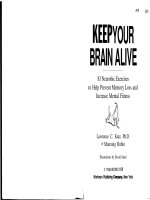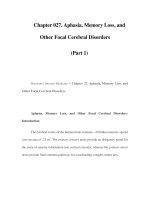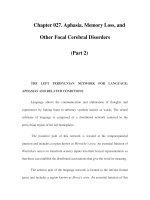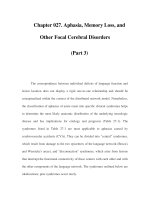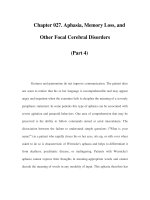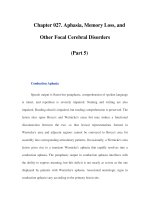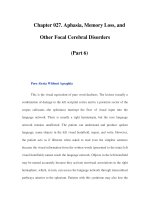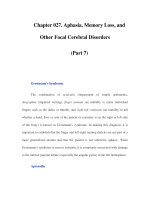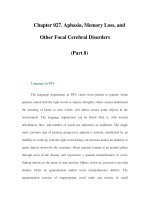Chapter 027. Aphasia, Memory Loss, and Other Focal Cerebral Disorders (Part 10) potx
Bạn đang xem bản rút gọn của tài liệu. Xem và tải ngay bản đầy đủ của tài liệu tại đây (63.32 KB, 5 trang )
Chapter 027. Aphasia, Memory Loss, and
Other Focal Cerebral Disorders
(Part 10)
Figure 27-3
Evidence of left hemispatial neglect and simultanagnosia. A. A 47-year-
old man with a large frontoparietal lesion in the right hemisphere was asked to
circle all the As. Only targets on the right are circled. This is a manifestation of
left hemispatial neglect. B. A 70-year-old woman with a 2-year history of
degenerative dementia was able to circle most of the small targets but ignored the
larger ones. This is a manifestation of simultanagnosia.Cerebrovascular lesions
and neoplasms in the right hemisphere are the most common causes of hemispatial
neglect. Depending on the site of the lesion, the patient with neglect may also have
hemiparesis, hemihypesthesia, and hemianopia on the left, but these are not
invariant findings. The majority of patients display considerable improvement of
hemispatial neglect, usually within the first several weeks.
Bálint's Syndrome, Simultanagnosia, Dressing Apraxia, and
Construction Apraxia
Bilateral involvement of the network for spatial attention, especially its
parietal components, leads to a state of severe spatial disorientation known as
Bálint's syndrome. Bálint's syndrome involves deficits in the orderly visuomotor
scanning of the environment (oculomotor apraxia) and in accurate manual
reaching toward visual targets (optic ataxia). The third and most dramatic
component of Bálint's syndrome is known as simultanagnosia and reflects an
inability to integrate visual information in the center of gaze with more peripheral
information. The patient gets stuck on the detail that falls in the center of gaze
without attempting to scan the visual environment for additional information. The
patient with simultanagnosia "misses the forest for the trees." Complex visual
scenes cannot be grasped in their entirety, leading to severe limitations in the
visual identification of objects and scenes. For example, a patient who is shown a
table lamp and asked to name the object may look at its circular base and call it an
ash tray. Some patients with simultanagnosia report that objects they look at may
suddenly vanish, probably indicating an inability to look back at the original point
of gaze after brief saccadic displacements. Movement and distracting stimuli
greatly exacerbate the difficulties of visual perception. Simultanagnosia can
sometimes occur without the other two components of Bálint's syndrome.
A modification of the letter cancellation task described above can be used
for the bedside diagnosis of simultanagnosia. In this modification, some of the
targets (e.g., As) are made to be much larger than the others [7.5–10 cm vs 2.5 cm
(3–4 in. vs 1 in.) in height], and all targets are embedded among foils. Patients
with simultanagnosia display a counterintuitive but characteristic tendency to miss
the larger targets (Fig. 27-3B). This occurs because the information needed for the
identification of the larger targets cannot be confined to the immediate line of gaze
and requires the integration of visual information across a more extensive field of
view. The greater difficulty in the detection of the larger targets also indicates that
poor acuity is not responsible for the impairment of visual function and that the
problem is central rather than peripheral. Bálint's syndrome results from bilateral
dorsal parietal lesions; common settings include watershed infarction between the
middle and posterior cerebral artery territories, hypoglycemia, sagittal sinus
thrombosis, or atypical forms of Alzheimer's disease. In patients with Bálint's
syndrome due to stroke, bilateral visual field defects (usually inferior
quadrantanopias) are common.
Another manifestation of bilateral (or right-sided) dorsal parietal lobe
lesions is dressing apraxia. The patient with this condition is unable to align the
body axis with the axis of the garment and can be seen struggling as he or she
holds a coat from its bottom or extends his or her arm into a fold of the garment
rather than into its sleeve. Lesions that involve the posterior parietal cortex also
lead to severe difficulties in copying simple line drawings. This is known as a
construction apraxia and is much more severe if the lesion is in the right
hemisphere. In some patients with right hemisphere lesions, the drawing
difficulties are confined to the left side of the figure and represent a manifestation
of hemispatial neglect; in others, there is a more universal deficit in reproducing
contours and three-dimensional perspective. Dressing apraxia and construction
apraxia represent special instances of a more general disturbance in spatial
orientation.
